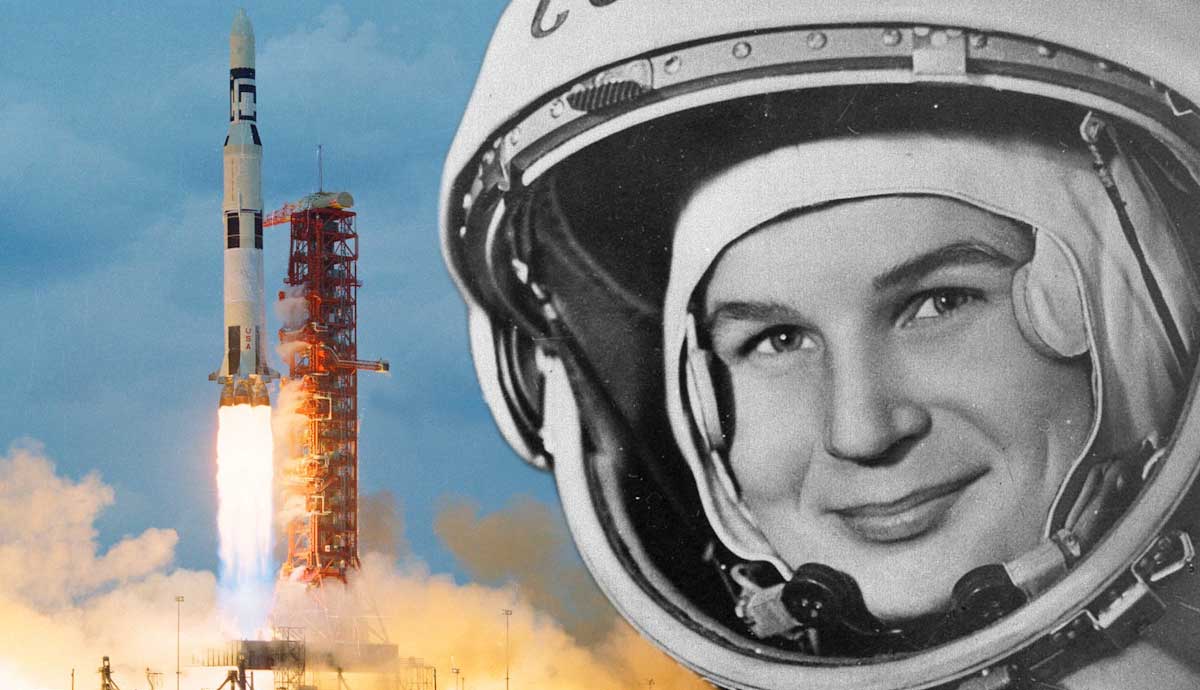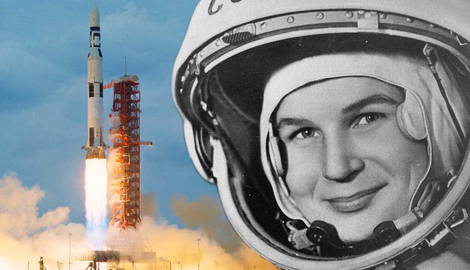
Aided by the terrifying advancements in rocketry during the Cold War, advancements in exploring beyond our planet saw a massive boost. Leading the way into space, predictably, were the Americans and the Soviets.
The two nations were not just locked in a deadly arms race but also in a race to achieve great things on the final frontier and prove to their own citizens that they were the best!
Here are 12 of the most important achievements in the Space Race.
1. The First Artificial Satellite: Sputnik 1

The Space Race kicked off on October 4, 1957, when Sputnik 1 was launched into orbit. Sputnik, which name translates as “Fellow Traveler,” was a two-foot wide metal ball with four protruding antennae. The entire object weighed less than 200 pounds, but it triggered a wave of fear in the United States as Americans woke up to the news that a Soviet satellite was orbiting over their heads.
Traveling at 18,000 miles per hour, the small object circled the Earth for three months, completing 1,440 orbits before burning up in the atmosphere upon re-entry. For 21 days after launch, Sputnik 1 transmitted a beeping sound, which to the Soviets was the sound of a great victory, but to the Americans, sounded like an ominous forecast of what the Soviet Union was capable of.
The event prompted the creation of NASA.
2. The First Animal in Orbit: Laika the Dog

On December 3, 1957, the Americans failed miserably when their attempt to launch a satellite into space exploded on launch. Meanwhile, the Soviets had already completed their next venture.
Sputnik 2 carried the first animal into orbit – a dog named Laika. The 13-foot cone-shaped capsule was launched into orbit on November 3, 1957. Laika was supposed to survive for ten days, but she perished after only a few hours due to rising temperatures in the capsule. Nevertheless, the mission was a success. It lasted 162 days, and Sputnik 2 completed 2,570 orbits.
Although the Soviets were proud of their achievement, the death of Laika, who was never supposed to survive, drew widespread criticism from the Soviet public.
3. The First Man-Made Object to Reach the Moon: Luna 2

On September 12, 1959, the Soviets launched Luna 2 as part of their Luna program, which was a series of robotic spacecraft missions sent to the moon. The following day, the spacecraft collided with the moon in a controlled impact.
Like the Luna Program, the Americans had the Ranger Program, which had the same goal of interacting with the moon.
Less than a month later, the Soviets launched Luna 3, which achieved another first in the Space Race by taking the first photographs of the dark side of the moon.
4. The First Man in Space: Yuri Gagarin

By the 1960s, it was clear that the United States needed a win in the Space Race. But their hopes were dashed again when the Soviets put the first man in space.
Yuri Gagarin was from a very humble background. The son of a carpenter and a dairy farmer, Yuri grew up on a state-owned farm. After joining the Soviet Air Force, he was later selected to be part of the Vostok Program, designed to put a human being in space.
Gagarin was popular among his peers, and of all the pilots selected to take part in the program, Yuri was voted by others to be the first man in space if they weren’t chosen. In the end, Gagarin was the one chosen, and on April 12, 1961, aboard Vostok 1, he became the first man to orbit the Earth. His flight lasted 108 minutes, and his spacecraft successfully re-entered the atmosphere and landed safely.
“Orbiting Earth in the spaceship, I saw how beautiful our planet is. People, let us preserve and increase this beauty, not destroy it!”
Yuri Gagarin
5. The First Woman in Space: Valentina Tereshkova

Like Yuri Gagarin, who had gone to space before her, Valentina Tereshkova was also from very humble beginnings. Her father was a tractor driver, and her mother worked in a textile factory. Following in her mother’s footsteps, Valentina also worked in a textile factory.
She was an avid skydiver, and her interest in aviation led her to become one of 400 candidates selected for the mission to put the first woman in space. The field was whittled down to five candidates who underwent training. Tereshkova was the one selected.
On June 16, 1963, Vostok 6 took off from the Baikonur Cosmodrome and took Valentina Tereshkova into space. She spent almost three days in orbit before returning safely to Earth.
6. The First Spacewalk: Alexei Leonov

After putting people in space, the next objective was survival outside of the spacecraft. This honor went to Alexei Leonov, a lieutenant in the 113th Parachute Aviation Regiment. He was selected for cosmonaut training in 1960, and the historic event happened on March 18, 1965.
The Voskhod 2 spacecraft was fitted with an inflatable airlock to allow the cosmonaut to exit and re-enter the spacecraft. On his 12-minute spacewalk, Alexei’s suit ballooned because of the lack of pressure, and he had to bleed it beyond safety limits to get back into the airlock. What could have been a disaster was narrowly avoided, and the Soviet Union achieved another first in the Space Race.
7. First Spacecraft to Land on the Moon: Luna 9

As part of the Soviet Union’s Luna Program, Luna 9 was tasked with landing on the moon without damage. Previous “landers” were simply tasked with crashing into the celestial object, but landing a craft safely was a much more difficult task.
On February 3, 1966, Luna 3 made the first soft landing on the surface of the moon, aided by inflatable balloons to soften the impact of the craft that was traveling 31 miles per hour. On June 2, the Americans would achieve the same feat with their spacecraft Surveyor 1.
8. First Crewed Landing on the Moon: Apollo 11

On July 21, 1969, the United States finally achieved a monumental victory over the Soviets when they landed the first men on the moon. Neil Armstrong and Buzz Aldrin stepped onto the moon’s surface. They unveiled a plaque, planted the flag, and left scientific equipment for future missions before blasting off back into space.
Several Apollo missions followed, with astronauts performing tasks on the surface of the moon. The United States is, to date, the only country to have sent human beings to the moon. It may not stay that way for long, though. The Europeans, the Chinese, and the Russians are all considering missions to the moon for various purposes.
9. First Spacecraft to Land on Another Planet: Venera 7

Although the Americans achieved the first flyby of Venus in 1972, it was the Soviets who achieved the most successes (and the most failures) regarding the hothouse world that is Earth’s nearest neighbor.
Following the missions to the moon, the focus shifted to other planets. The Soviets gained this achievement by landing Venera 7 on the surface of Venus on December 15, 1970.
The lander flew through the thick Venusian atmosphere and landed on the ground at approximately 39 miles per hour. The probe seemed to go silent on impact, leading the scientists back on Earth to believe that the probe was completely destroyed, but the tapes on the probe kept rolling, and the signals were eventually picked up.
The temperature on Venus was discovered to be 887 °F (475 °C).
On June 8, 1975, Venera 9 would send back the first images of the surface of Venus, and in October 1981, Venera 13 would be the first to record the sounds on another planet.
10. First Space Station: Salyut 1

After several catastrophic N-1 launches in the Soviet’s program to put people on the moon, Leonid Brezhnev canceled the program in 1974 and focused on getting one up on the Americans in developing an orbiting space station. On April 19, 1971, Salyut 1, the world’s first space station, was launched into low Earth orbit.
The lifespan of the station was relatively short and filled with malfunctions, especially with the docking of the Soyuz capsules. Nevertheless, valuable data was collected through experiments and observation aboard Salyut 1.
Salyut’s mission was terminated after 175 days, and the station was brought into a decaying orbit to burn up in the atmosphere on October 11, 1971.
11. First Spacecraft to Land on Mars

On November 28, 1964, the United States achieved the first flyby of Mars with Mariner 4, but it would be many years later that a lander would be able to achieve a soft landing on the surface of the Red Planet. On November 27, 1971, the Soviet Mars 2 became the first spacecraft to orbit Mars. Equipped with a lander and a rover, the mission failed to achieve a soft landing and instead achieved the first impact on Mars.
Not long after, on December 2, 1971, Mars 3 made the first soft landing, but the instrumentation on the lander failed, and contact with the lander was lost after a few seconds. The mission was deemed a partial success.
The first fully successful mission came on July 20, 1975, with the Viking 2 lander sent by the United States.
12. First Flybys

While the Soviet Union certainly achieved the most number of important firsts in the Space Race, usually going unmentioned were the important visits to our celestial neighbors. Pioneer 10 flew past Jupiter on December 3, 1973. Mariner 10 flew past Mercury on March 29 of the following year. Pioneer 11 achieved the first flyby of Saturn on September 1, 1979. And Voyager 2 did the same with Uranus and Neptune in 1986 and 1989, respectively.
All these spacecraft were American. Shortly afterward, in December 1991, the Soviet Union was dissolved, signaling an end to the Space Race.

The question of who “won” the Space Race is controversial. Many would argue that landing a man on the moon was the ultimate goal, and the United States was therefore the winner; most others would disagree. By looking at the sheer number of firsts achieved, it is impossible to reasonably declare the United States as having won the Space Race. Nevertheless, the discussion as to whether it was or wasn’t a race and who the winner was, is purely speculative and does not necessarily merit academic attention.
What’s important is the scientific achievements of humanity, and in this, the ambassadors to space have achieved much, especially when working together. Despite geopolitical factors, The Soviet Union (now Russia) and the United States have remained on peaceful and friendly terms outside the Earth’s atmosphere. They have worked and lived beside each other on space stations, becoming friends in the process, unobstructed by international politics.










